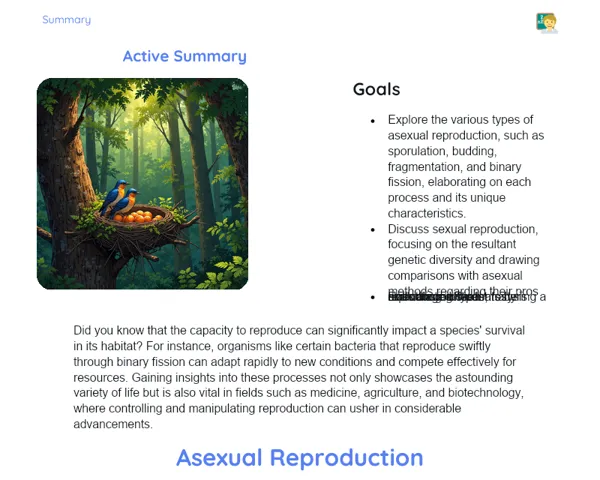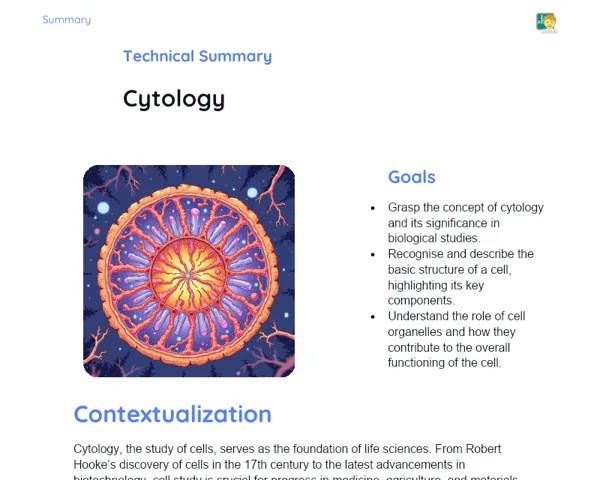Socioemotional Summary Conclusion
Goals
1. 🔍 Identify and describe the different types of digestive systems in herbivorous animals, humans, and birds.
2. 🔬 Understand the key differences and similarities between the digestive systems of these animals, highlighting their unique functions and characteristics.
3. 🤔 Reflect on how the eating habits of various species have evolved according to their digestive systems, promoting awareness of biodiversity.
Contextualization
🌍 Did you know that cows possess four compartments in their stomachs? This configuration helps them digest fibrous plants extremely efficiently! Humans, on the other hand, have a flexible digestive system that allows us to enjoy a diverse range of foods. And what about birds? They have a fascinating adaptation with the gizzard that grinds their food! Understanding these differences not only enhances our appreciation of the natural world but also highlights the remarkable diversity of life. Are we ready to embark on this exciting journey through the digestive systems of animals? 🚀
Exercising Your Knowledge
Digestive System of Ruminants
Ruminants, like cows and sheep, have a remarkably specialized digestive system that enables them to extract nutrients from fibrous plants. This system is made up of four main compartments: rumen, reticulum, omasum, and abomasum. Each compartment plays a vital role in the digestion of cellulose and other fermentation processes, making these animals well-suited for a herbivorous diet.
-
Rumen: Acts as a fermentation chamber where microorganisms assist in breaking down cellulose, allowing the animal to absorb nutrients from coarse plants.
-
Reticulum: Works closely with the rumen to hold and process larger food particles, enhancing the digestive process.
-
Omasum: Absorbs water and digested nutrients, essentially functioning as a filter.
-
Abomasum: Known as the 'true stomach', where enzymatic digestion occurs, similar to that in humans.
Digestive System of Humans
The human digestive system is adaptable and designed to process a wide range of foods. It consists of several interconnected parts, including the mouth, esophagus, stomach, intestines, and accessory organs like the liver and pancreas. Each part has a specific role, from chewing and the initial breakdown of food in the mouth to the final absorption of nutrients in the small intestine.
-
Mouth: Begins digestion through chewing and the action of enzymes found in saliva.
-
Esophagus: The tube that carries food from the mouth to the stomach through muscular contractions.
-
Stomach: Uses gastric acid and enzymes to dismantle food into smaller molecules.
-
Small Intestine: The primary site for nutrient absorption, where pancreatic enzymes and bile aid in the final stages of digestion.
-
Large Intestine: Absorbs water and forms waste, subsequently eliminated from the body.
Digestive System of Birds
Birds possess a digestive system optimized for quick and efficient food processing. This system features unique structures like the crop, which stores and softens food, and the gizzard, which mechanically grinds food with the help of small stones gathered by the bird. The food then moves on to the proventriculus for chemical digestion before nutrient absorption in the intestine.
-
Crop: Stores and softens food before grinding, initiating digestion early.
-
Gizzard: Mechanically grinds food with the aid of ingested small stones, facilitating subsequent chemical digestion.
-
Proventriculus: Conducts initial chemical digestion using enzymes and digestive acids.
-
Intestine: Absorbs nutrients from digested food, completing the digestion process.
Key Terms
-
Rumen: The first chamber in the stomach of ruminants where microbial fermentation of food takes place.
-
Reticulum: The second compartment of the stomach in ruminants, working alongside the rumen in the initial digestion.
-
Omasum: The third compartment that absorbs water and nutrients from digested food.
-
Abomasum: The 'true stomach' of ruminants, where enzymatic digestion occurs.
-
Peristalsis: Muscle contractions that push food through the digestive tract.
-
Crop: A structure in the digestive system of birds that stores and softens food.
-
Gizzard: A part of the avian digestive system responsible for mechanically grinding food.
-
Proventriculus: The stomach compartment in birds where initial chemical digestion takes place.
For Reflection
-
💡 How does the structure of each animal's digestive system reflect their dietary preferences and environmental needs?
-
💡 In what ways does the variety of digestive systems among different species enhance our understanding of biological adaptability and evolution?
-
💡 How can insights about digestive systems shape our choices regarding sustainability and respect for biodiversity?
Important Conclusions
-
📚 Ruminants have a specialized digestive system designed for processing fibrous plants, comprising four key compartments: rumen, reticulum, omasum, and abomasum.
-
👨🔬 The human digestive system is flexible and equipped for a varied diet, incorporating the mouth, esophagus, stomach, intestines, and accessory organs like the liver and pancreas.
-
🐦 Birds possess a digestive system tailored for swift food digestion, featuring the crop, gizzard, and proventriculus.
-
🌱 The diversity of digestive systems exemplifies how different species have adapted to their specific dietary practices and environments.
Impacts on Society
🌿 Comprehending the different digestive systems is crucial for agricultural practices and conservation efforts. For instance, knowledge about ruminant digestion can enhance livestock feeding and boost agricultural productivity. A better understanding of the human digestive system allows for improved comprehension of nutrition and health, impacting our food choices and lifestyles.
🌍 Furthermore, awareness about the digestive systems of birds can inspire the protection of their natural habitats and encourage sustainable poultry practices. Realizing these differences and their ecological implications prompts us to reflect on our responsibility towards biodiversity preservation and sustainable actions in our daily lives.
Dealing with Emotions
🧘♂️ To help you manage your emotions while studying this intriguing topic, I suggest an exercise based on the RULER method. Begin by recognizing and naming the emotions you experience when learning about digestive systems. These might include curiosity, surprise, or maybe even some frustration. Next, explore what triggered these emotions and how they influenced your interest and motivation. Channel these emotions constructively: jot them down in a journal or discuss them with a colleague. Finally, work on regulating these emotions. If frustration arises, take short breaks and practice deep breathing. If motivation strikes, use that energy to delve deeper into the topic. This approach will facilitate a healthier and more productive relationship with your studies.
Study Tips
-
👩🏫 Group Study: Form small study groups to discuss and compare digestive systems. Each member can focus on researching a specific animal and then share their findings with the group, enhancing collective understanding.
-
📑 Mind Maps: Create mind maps or comparative diagrams to visually represent the differences and similarities among the digestive systems of ruminants, humans, and birds. Employing various colors and images can aid in memory retention.
-
🔍 Online Resources: Utilize educational videos and infographics available online to visualize how various digestive systems operate. Platforms like YouTube and Khan Academy are excellent sources for engaging content.



